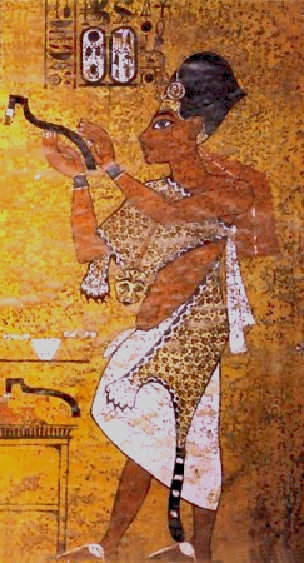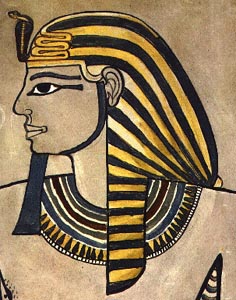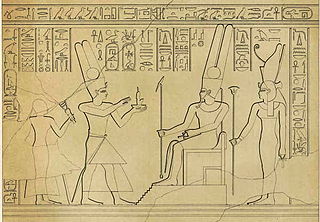Related Research Articles

Ay was the penultimate pharaoh of ancient Egypt's 18th Dynasty. He held the throne of Egypt for a brief four-year period in the late 14th century BC. Prior to his rule, he was a close advisor to two, and perhaps three, other pharaohs of the dynasty. It is speculated that he was the power behind the throne during child ruler Tutankhamun's reign. His prenomenKheperkheperure means "Everlasting are the Manifestations of Ra," while his nomenAy it-netjer reads as "Ay, Father of the God." Records and monuments that can be clearly attributed to Ay are rare, both because his reign was short and because his successor, Horemheb, instigated a campaign of damnatio memoriae against him and the other pharaohs associated with the unpopular Amarna Period.

Menpehtyre Ramesses I was the founding pharaoh of ancient Egypt's 19th Dynasty. The dates for his short reign are not completely known but the timeline of late 1292–1290 BC is frequently cited as well as 1295–1294 BC. While Ramesses I was the founder of the 19th Dynasty, his brief reign mainly serves to mark the transition between the reign of Horemheb, who had stabilized Egypt in the late 18th Dynasty, and the rule of the powerful pharaohs of his own dynasty, in particular his son Seti I, and grandson Ramesses II.

Amenhotep II was the seventh pharaoh of the Eighteenth Dynasty of Egypt. Amenhotep inherited a vast kingdom from his father Thutmose III, and held it by means of a few military campaigns in Syria; however, he fought much less than his father, and his reign saw the effective cessation of hostilities between Egypt and Mitanni, the major kingdoms vying for power in Syria. His reign is usually dated from 1427 to 1401 BC. His consort was Tiaa, who was barred from any prestige until Amenhotep's son, Thutmose IV, came into power.

The New Kingdom, also referred to as the Egyptian Empire, is the period in ancient Egyptian history between the sixteenth century BC and the eleventh century BC, covering the Eighteenth, Nineteenth, and Twentieth dynasties of Egypt. Radiocarbon dating places the beginning of the New Kingdom between 1570 BC and 1544 BC. The New Kingdom followed the Second Intermediate Period and was succeeded by the Third Intermediate Period. It was Ancient Egypt's most prosperous time and marked the peak of its power.

Shebitku also known as Shabataka or Shebitqo, and anglicized as Sethos, was the second pharaoh of the Twenty-fifth Dynasty of Egypt who ruled from 714 BC – 705 BC, according to the most recent academic research. He was a son of Piye, the founder of this dynasty. Shebitku's prenomen or throne name, Djedkare, means "Enduring is the Soul of Re." Shebitku's queen was Arty, who was a daughter of king Piye, according to a fragment of statue JE 49157 of the High Priest of Amun Haremakhet, son of Shabaka, found in the temple of the Goddess Mut in Karnak.

Nubkaure Amenemhat II, also known as Amenemhet II, was the third pharaoh of the 12th Dynasty of ancient Egypt. Although he ruled for at least 35 years, his reign is rather obscure, as well as his family relationships.

The Tombos Stela is an ancient Egyptian rock inscription found in the area of Tombos (Nubia), dated to Year 2 of Pharaoh Thutmose I. It attests to his military campaign into Nubia around the area of the 3rd cataract of the Nile. It was discovered around 1829, on a large boulder in Tombos, Nubia on the east bank of the Nile. Thutmose is known to have expanded Egypt’s borders throughout his reign, not only in Nubia, but also by campaigns in the Syria-Palestine area. During the Middle Kingdom, pharaohs such as Mentuhotep II had already expanded into Nubia. However, scholars argue that the Tombos stela is evidence of farther expansion by Thutmose into Nubia than previous kings.

Anlamani was a king of the Kingdom of Kush in Nubia, who ruled from 620 BC and died around 600 BC.

The Kingdom of Kush, also known as the Kushite Empire, or simply Kush, was an ancient kingdom in Nubia, centered along the Nile Valley in what is now northern Sudan and southern Egypt.
Seti or Suti was an ancient Egyptian soldier during the late 18th Dynasty, the commander of the army, later mentioned as vizier on monuments of his son, Pharaoh Ramesses I. Seti, the forefather of the 19th Dynasty, was from a military family in the Nile Delta. According to one theory he is identical with a royal envoy mentioned in the Amarna letters as Shuta.

Merymose, also Mermose or Merimes, was a Viceroy of Kush under Amenhotep III. He served for almost the entire four decades of that reign.
Parennefer also called Wennefer was a High Priest of Amun during the reigns of Tutankhamun and Horemheb. He was previously thought to date to the time of Ramesses II, but he is now dated to the end of the Eighteenth Dynasty. Parennefer was more firmly put at the end of the Eighteenth Dynasty after extensive excavations of his tomb in Thebes in 1990–1993.

Wentawat, was Viceroy of Kush under Ramesses IX, during the 20th Dynasty. He was a son of the Viceroy Nahihor.

Abar was a Nubian queen of the Kingdom of Kush dated to the Twenty-fifth Dynasty of Egypt. She is known from a series of stela found in Sudan and Egypt. Her appearances mark her as the niece of King Alara of Nubia, married to King Piye and the mother of King Taharqa.

The Eighteenth Dynasty of Egypt is classified as the first dynasty of the New Kingdom of Egypt, the era in which ancient Egypt achieved the peak of its power. The Eighteenth Dynasty spanned the period from 1550/1549 to 1292 BC. This dynasty is also known as the Thutmosid Dynasty for the four pharaohs named Thutmose.
This page list topics related to ancient Egypt.

Heqanefer was an ancient Egyptian official in the New Kingdom under king Tutankhamun, who was a local governor with the title Chief of Miam. In the New Kingdom, Egyptian kings had conquered Lower Nubia. To secure control over the new region they appointed people of the local elite as governors. Miam was a town in Lower Nubia, a regional center and capital of the Nubian provinces. Here also resided the Chief of Miam. Heqanefer is known from his badly preserved rock cut tomb found at Toshka. Here he is depicted as Egyptian.

Taemwadjsy was an Ancient Egyptian woman living at the end of the 18th Dynasty.
Khay was an ancient Egyptian official in charge under king Tutankhamun. He was child of the Nursery, but also fan bearer on the Right of the King, troop Commander and overseer of Southern Foreign Lands. The titles provide evidence that he was one of the most important officials in Nubia, that was at this time under Egyptian control. Khay is known from a depiction on a temple wall at Kawa and from his sarcophagus, now in the Egyptian Museum in Cairo. On the temple wall, king Tutankhamun is mentioned too, providing a clear date for the official.
Paenniut was an important Ancient Egyptian official in charge during the reign of Tutankhamun. He is depicted in tomb TT40 that belongs to the viceroy of Kush Amenhotep called Huy and is also known from a stela found in the Kurkur Oasis. In the tomb of Amenhotep/Huy he bears the title deputy of the fortress of Faras. On the stela he bears several titles, including overseer of the double granary, and governor in Dwatnefert. The most important title was however deputy of Wawat. Wawat was the Egyptian word for Lower Nubia and was with this position, Paenniut was one of the most important officials in charge of this province that was in this time under Egyptian control.
References
- ↑ Nozomu Kawaiː The Administrators and Notables in Nubia under Tutankhamun, in Richard Jasnow and Kathlyn M. Cooney (eds), Joyful in Thebes: Egyptological Studies in Honor of Betsy M. Bryan, Atlanta: Lockwood, 2015, ISBN 9781937040406, 316